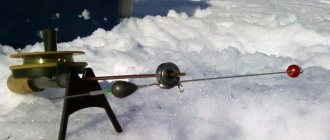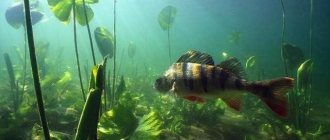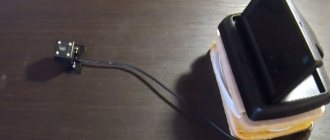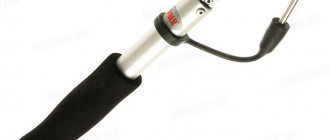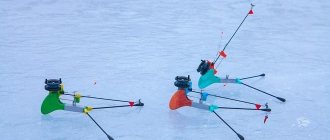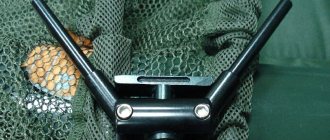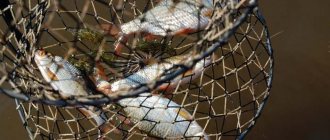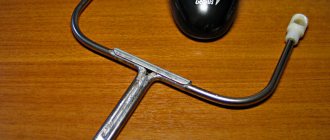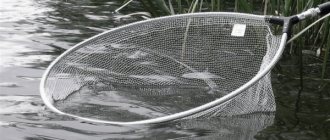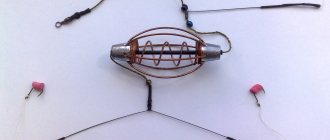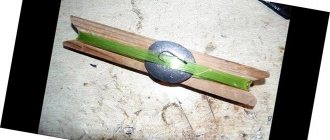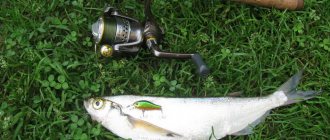Fishing elastic rightfully belongs to one of the classic types of bottom tackle, which is widespread and used even in our time, characterized by the possibility of using high-tech materials and fishing methods. A distinctive feature of this design, and catching a predator with an elastic band is as common as catching peaceful fish, is its versatility.
The ability to quickly reconfigure equipment with a minimum of manipulation to catch another fish seduces the fisherman, and the fishing process itself and its final goal become more likely with an increase in the chances of a final positive result. The presented article will give the fisherman knowledge in the field of assembly and structural features of this already considered old-fashioned, but no less effective gear, and will also help to understand the nuances of fishing techniques and planning its strategy based on the structure of the fished reservoir.
What is a fisherman's rubber band?
Elastic band fishing is one of the areas of bottom fishing, the equipment of which does not require a fishing rod. The main design feature of this type is the presence of a shock absorber in the design of the equipment, which is an intermediate link between the sinker and the main cord. Thanks to this element, when fishing with an elastic band, the sinker does not need to be recast after checking the baits and retrieving the caught trophy.
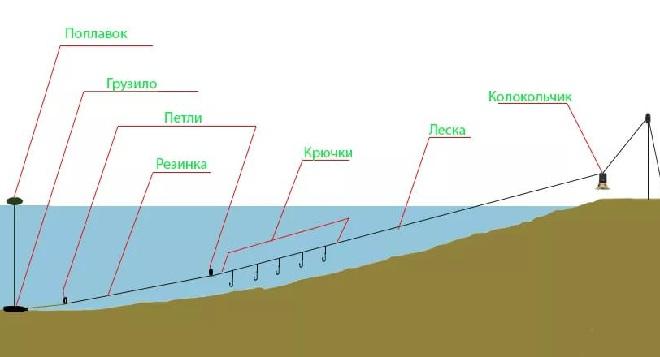
To do this, you just need to install or throw a load into the reservoir at the beginning of fishing, and then use the high stretch coefficient of the rubber shock absorber to remove the cord with leads. These qualities of the rubber band make the fishing method silent, classifying it as a delicate and delicate hunt with a high degree of catchability of many types of fish.
The process of fishing with an elastic band
After importing or casting the tackle, baits are put on the hooks and the fishing line is released into the water to its full length. Installing a signaling device also simplifies the fishing process, and its type and design are selected depending on the financial capabilities of the fisherman.
But, despite the fact that a donka with an elastic band does not require constant attention, it is problematic to fish with more than two tackles at the same time. Still, the presence of several hooks on each tackle increases the likelihood of a bite and the angler must make a timely hook. Hooking is done with a sharp movement towards the shore; to simplify the process of landing fish, a landing net with a long handle is used.
You should bring the fish to the shore smoothly, without sudden jerks, so that the trophy does not come off the hook. Before launching the tackle into the water, you need to make sure the hooks are sharp and put bait on each of them. In order to quickly attach the fishing point to the swivel connecting the rubber and hooks, attach a feeder feeder or a spring with bait.
But you need to take into account that additional weight makes the tackle heavier, which means it does not fall into the right place. To solve the problem, small pieces of dough made from corn flour and semolina or bread crumb are stuck directly onto the fishing line between the hooks.
Advantages and disadvantages
Fishing with a rubber band has a number of clear advantages over most other fishing methods, not just bottom fishing. In addition to the above-mentioned silent delivery of bait, another advantage is the ability to cover a long fishing distance with bait installations along the entire trajectory of the gear installation. An important point is the quick change of leashes, which allows you to change not only their size, but also the type of hook for a radically new type of bait. After re-equipping, the bottom with a rubber shock absorber returns to the starting point without distorting the previously selected installation line, which, when using bait, increases the efficiency of the fish’s approach to the bait.
The shock absorber helps to catch large fish on thin rigs, making the rig less noticeable and therefore more attractive to the trophy. The disadvantages of this type of donkey include its high windage, which is greatly manifested when fishing in currents and long distances. Impossibility of use in conditions of snags and overgrown bottoms. Frequent overlaps of leashes and main lines also cause inconvenience, especially if the angler’s executive technique is at the initial stage of mastering this method of bottom fishing.
Fishing gum
Elastic band (regular option)
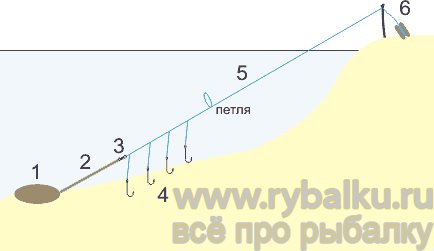
- Cargo.
- Rubber shock absorber ( fishing rubber ).
- Swivel.
- Leashes with hooks.
- Main line.
- Reel with a supply of fishing line.
A supply of fishing line 0.35 - 0.4 mm long, 80-100 m long, is wound on the reel. To avoid twisting of the tackle due to stretching of the fishing elastic, the end of the fishing line is tied to a large swivel.
A fishing elastic band is tied to the swivel. First, pass the fishing elastic through the eye of the swivel 3-5 times, and then tie 5-7 regular, “woman’s” knots. It is necessary to leave a 2-3 centimeter “tail” so that when the fishing elastic is stretched, the knot does not come undone. When tightening the knots, the fishing elastic (as well as the fishing line) must be moistened with water.
You cannot tie a fishing elastic band directly to the sinker - it will quickly fray. A rope is tied to the fishing elastic. This can be a nylon cord or keeper tape. A loop is made on the rope, and a fishing elastic band is tied to it in the same way as to a swivel.
The load is tied with a rope. If the gum is brought in by boat, it is usually a stone, half or whole brick, or a bag of sand. So that you can later find and remove the load, a buoy is tied to it on a nylon cord - an empty 1.5 liter plastic bottle, or a large piece of polystyrene foam.
If the tackle is thrown by hand, then it will be various sinkers made of lead or other metal. The weight must be heavy enough to hold in place when you begin to select line to test hooks or land fish. But at the same time, it’s light enough to cast, and then you can pull it out with a fishing elastic. Although when a fishing elastic breaks, the losses are usually not great, as it breaks in the knot near the sinker.
What fishermen don’t use! I've seen a hacksaw, a 32mm wrench, a Volga brake pad, and even a meat grinder used as a sinker.
A railway spike - a large nail driven into wooden sleepers - is well suited as a sinker for fishing with an elastic band. It has the “just right” weight, and thanks to the protruding “cap”, when the elastic band is pulled, it clings to the ground and remains in place. They tie a crutch to the “hat”.
To make casting easier, a 50-centimeter cord is tied to the crutch, at the end of which a “holder” is attached: a 5-centimeter wooden stick. With such a device, the cargo flies much further. It makes sense to practice on the shore, throwing a sinker without an elastic band. Otherwise, you can cast in such a way that the sinker flies high up and falls five meters from the angler.
On rivers with large currents, fishermen cast lead weights in the shape of a crutch. To do this, the lying crutch is completely immersed in damp sand, then carefully pulled out, and molten lead is poured into the resulting form.
More recently, I started using a “one and a half pound” filled with raw sand as a sinker. On the shore, as a rule, there are sufficient quantities of empty bottles lying around, so making a load is not a problem. I pour the sand and compact it, close the bottle with a lid. I tie a piece of rope to the neck with a loop at the end, to which I tie an elastic band. I set the sinker while swimming. “One and a half” with sand holds the line well in the current, and is easily pulled out of the reservoir directly on the elastic band.
Leashes are tied to the main line in different ways. Most often, loops are made on the main line. Leashes are tied to them using the “loop-to-loop” method. This method is bad because the leashes constantly get tangled when the main line is twisted. A more perfect way is to tie 2 beads on the fishing line instead of a loop (see the picture of fishing for pike perch with an elastic band below). The fishing line is passed through the hole of the bead several times. Attach the leash between them using a small carabiner without a swivel. Then, when the main line is twisted, the leashes will remain in place. And after fishing, removing leashes with carabiners is easier than stretching the loop.
For elastic fishing for sabrefish, bream, crucian carp and other peaceful fish, the leashes should be 20-30 cm long. The distance between the beads is no more than 5 cm. The distance between the leashes is about a meter. When fishing for pike perch, perch, pike with a rubber band using fry or live bait, the distance between the beads should be greater: 40-50 cm, leashes 50-60 cm.
To prevent the leashes from getting tangled and interfering with casting, they need to be placed on an already abandoned/imported fishing line and removed after fishing. It is advisable to store them in a special device for transporting leashes.
After the leashes, a loop is made on the main line. It is hooked onto the spear when setting hooks and removing fish.
The main line along with the fishing elastic is wound on a reel. To prevent the reel from breaking due to the compression of many turns of the fishing elastic, it is wound with a slight slack, not tightly. To avoid twisting, it is better to lay the elastic band on the reel in a zigzag pattern.
Fishing with an elastic band - what kind of fishing elastic do you need?
The best fishing elastic sold in fishing stores is round, white or blue. On an elastic band with a square cross-section, burrs form, along which it then breaks. A yellow rubber band will also work, but it is less durable.
Previously, when there was no special fishing elastic , it was woven from aircraft model rubber with a diameter of 1-2 mm in 4-8 layers. To do this, the elastic band was folded in half, a small “skewer” of wire was passed into the folded area, and twisted. Then the elastic band was folded in half, and it twisted itself, “woven together.” Then they twisted it again, folded it in half, etc., until they reached the desired number of layers. This fishing elastic is stronger than a single one, but it twists the line a lot.
Fishing elastic with a diameter of 2.5-3.5 mm is used only in still water. An elastic band with a diameter of 4 mm is the most popular. It is used in still water and moderate currents when casting a sinker by hand. In strong currents, use a 6 mm elastic band. Heavy cargo is transported by swimming or by boat.
How to calculate the length of a fishing elastic for fishing with an elastic band?
Typically, fishing elastic can stretch 7-8 times. But this is already the limit. In order to have a margin of safety, take into account the six-fold stretch of the elastic band - this is the best option. Calculate the length of the fishing elastic using a simplified formula:
L elastic bands = L catches: 5
Where
L elastic bands
- the required length of the fishing elastic.
L catching
— the distance to which you want to deliver the hooks with the nozzle.
Why divide by 5 and not by 6? Because you need to add the length of the elastic itself.
That is, if you want to fish 25 meters from the shore, put a 5-meter rubber band, 50 meters - 10 meters, 75 meters - 15 meters, etc.
Calculate the length of the elastic band, fishing line and the distance of throwing the sinker:
Remember that the main line must be taken with a reserve, especially when fishing in the current, when the line bends into an arc.
Basic elements of elastic
The elastic tackle is based on a reel, which, due to its volume, allows you to store the required length of the shock absorber and the main cord. The frame of the tackle is the main cord, which can be made of monofilament or braided fishing line. The next element of the equipment is the shock-absorbing elastic band itself, which is attached to the end of the main cord, and at the end of the shock absorber itself, a sinker is attached to it. The most useful equipment for fishing is leashes with hooks. They are connected to the main line through a certain distance required by fishing conditions.
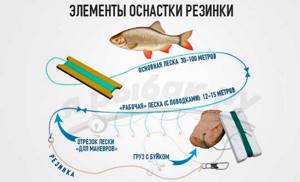
Sometimes, for specific hunting conditions that require holding baits at certain levels of the water column, anglers use foam weights of various weights, which are additionally mounted on a leash. The donkey also includes a signaling device that can notify the fisherman in some effective way that a bite has occurred.
Features when fishing with a rubber band for some types of fish
Tightening sabrefish with a modernized elastic band
This fish is caught from late spring, the beginning of spawning, and until the beginning of autumn. Zhor can last even after the end of spawning. The main feeding area of sabrefish in summer is located near shallows, sandy and pebble. Closer to spring, the fish slide into deep-sea holes.
Since sabrefish feeds mainly in the upper layers, the main difference in the structure of the tackle is the presence of a float between the elastic band and the main fishing line. It comes in a variety of modifications. This includes a simple foam ball with a through hole through which the main line is passed several times, and commercial plastic floats. The most convenient is a spherical plastic float with two ears (Cheburashka design), which is also used for live bait fishing.
Structurally, the rubber band for hunting sabrefish consists of the following elements:
- sinker;
- shock-absorbing rubber cord;
- holding float;
- leashes on swivels;
- main cord;
- reel;
- cord for removing the sinker, with or without a float, depending on the type of casting.
We recommend reading: Characteristics of spinning reels, tips for choosing them
One of the most popular baits when fishing for sabrefish are maggots, which are placed on a hook in a garland of 4 pieces, piercing them near the thickening of the body, and the 5th piece covers the tip of the hook, placing it along the entire body.
You can also use artificial bait, such as foam balls. Artificial maggots have proven themselves well. To make it, you need to take finely porous foam rubber, cut it into proportionate pieces and soak it in salted, loose egg white, and then cook in boiling water for a minute.
Chekhon is a relatively peaceful fish; in the fall it can be caught with small live bait, fry or artificial silicone bait, for example, a light-colored twister (white or yellow).

A necessary condition for catching sabrefish with an elastic band is playing with bait, since the fish responds better to a moving bait. The technique is as follows:
- the main line is slightly pulled up;
- after 5 seconds, slowly release to arm’s length;
- there is a pause of 3 seconds, followed by a sharp hook;
- everything repeats itself from the beginning.
- If the bite is bad, then it is necessary to vary the speed of performing the stages; it also happens that the saberfish takes a calmly hanging bait.
We must not forget that feeding fish greatly increases the likelihood of a positive fishing outcome. The first way to attract the attention of sabrefish is to modify the elastic tackle, and a prerequisite is the delivery of the sinker by boat. A net with a fine mesh is tied to the cord for the recess with a float, into which the complementary foods are placed. The current washes out pieces of bait and carries them downstream. Flocks of sabrefish show interest specifically in the source of food, showing little interest in small fractions, so they swim specifically to the feeder.
As a filler, you can use a mixture of millet porridge and egg, diluted with ground breadcrumbs in equal parts. The technology for preparing porridge is as follows:
- take half a glass of millet and the same amount of egg, pour it into the pan;
- add a couple of glasses of water;
- bring to a boil and cook over low heat, stirring occasionally, until the water is completely absorbed by the cereal.
The second method can also be used when fishing without a boat. To do this, you need to take a small plastic bottle (~0.2 l) and drill small holes in it. Then tie it to the main line closer to the float. Complementary feeding is provided as needed.
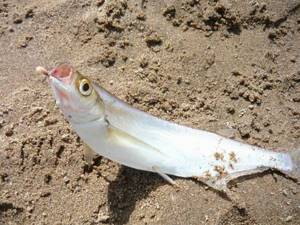
Fishing for pike perch using an elastic band in the dark
Pike perch also hunts at night. Since this is a predatory fish, the bait is a fry, and it doesn’t matter if it’s alive or dead. Large fish can be cut into portioned pieces, and the tail part of the pike perch seems much more attractive than the head. The main diet is ruff or bleak.
The main hunting grounds are places with sharply changing bottom topography. Here it is better to install several rigs equipped with 3-4 hooks than one with 10. The casting range is also minimal, not exceeding 20 meters, so when delivering the sinker you can do without a boat.
Structurally, the gear structure is somewhat modified relative to the classic version and consists of the following parts:
- sinker, cord and shock-absorbing elastic, mounted in the usual way;
- to connect the elastic band and the main cord, a light (30-40 grams) weight with two eyes, “Cheburashka” type, is used;
- beads to limit the movement of the leashes are located at a distance of half a meter in the movement zone of the fastening carabiner and 2 meters from the central parts of these sections (from each other).
No feeding is required during fishing. This gear can also be used to hunt other predators, for example, perch in the daytime. When the air temperature becomes sub-zero and the water becomes very cold, burbot can be caught very well at night using an elastic band. As a bait, you can use any animal origin, and it’s good if it’s slightly rotten; burbot is an orderly for water bodies and reacts positively to this smell.
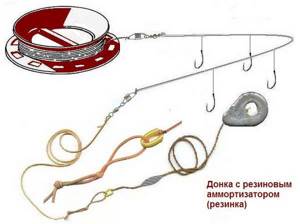
Fishing for crucian carp using a tackle with an elastic band
Crucian carp is a peaceful fish belonging to the carp family, so everything written can be used when fishing for carp, bream, roach, etc. It must be remembered that crucian carp are most active in the early morning, before 10 o’clock and late in the evening, although there were cases when the fish was “walking” - it was caught all day. However, specimens weighing more than 500 grams are found only at dawn. You need to look for crucian carp in swampy ponds with a muddy bottom or at the edge of aquatic vegetation, since they find everything they need there - food and shelter.
A distinctive feature of the elastic tackle for crucian carp is the presence of feeders from feeders on it; the fishing tactics are borrowed from the tackle of the same name, however, the elastic has an undeniable advantage - noiselessness and high accuracy of delivery of complementary food to the fishing site. To set up the gear, spring feeders are installed in the space between the leashes and filled with the necessary mixture. The remaining stages of fishing are similar to traditional methods.
Various cereals with flavoring and aromatic additives are used as complementary foods: sunflower cake, hemp oil, anise oil, crackers, etc. You can also use store-bought complementary foods as a base.
A variety of options are also used for the nozzle. These include dung worms, maggots, steamed pearl barley or peas, pickled corn, bread crumbs and dough. Moreover, various oils are often added to the latter; anise and garlic are considered the most popular.
As you can see, the elastic band is a very versatile tackle. With the right choice of place, you can try out a wide variety of lures, lures and attachments, thus studying the habits of fish in the fished body of water. Consequently, the elastic band can also act as an auxiliary tackle. As an independent fishing tool, it is very effective and will help the fisherman if he needs to return with a good catch.
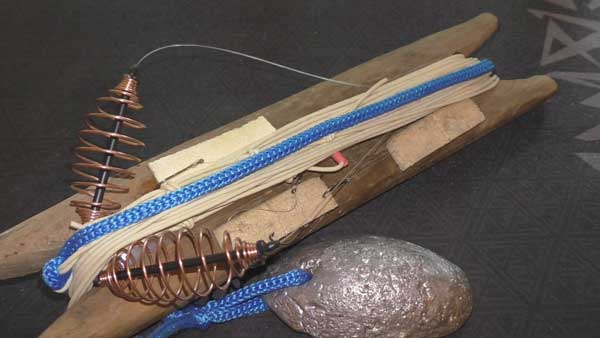
Who and where can you catch with a rubber band tackle?
You can catch almost any fish that lives in our reservoirs with an elastic band. But in practice, there are a number of targeted fishing sites to which fishermen most often go with this bottom equipment. Among the peaceful fish are crucian carp, bream, carp, roach, sabrefish, selected gudgeon and ruff. This predator is used for fishing for pike, perch, catfish and pike perch. The fishing spots themselves are selected based on several characteristics, the most important of which is the presence of a relatively clean bottom without snags, drifts of construction debris and dense underwater vegetation. Water areas with sharp drops of the bottom from the shallows into the depths are not suitable for fishing. Smooth changes in depth, smooth underwater plateaus, the boundaries of clear water near thickets and reed walls are ideal trajectories for fishing. Installation of rigs with an elastic band is possible both in the current and in reservoirs with standing water, which only makes fishing even more comfortable.
Equipment equipment
Fishing elastic consists of several parts.
Rubber
When choosing this part of the tackle, you must take into account the following properties of the elastic:
- elasticity;
- elongation factor several times its original length;
- load capacity;
- resistance to aggressive environments;
- the woven rubber shock absorber is rougher and stiffer;
- Use the rubber tape monolithically, in one piece. It often breaks at the knots.
When fishing with this tackle, experienced fishermen use two types of rubber shock absorbers: flat, narrow (noodle) and round (Hungarian).
Noodles:
- a more common type, more often found in markets and stores;
- elongation coefficient 1.3–1.4;
- has increased resistance to frequent casting;
- long service life.
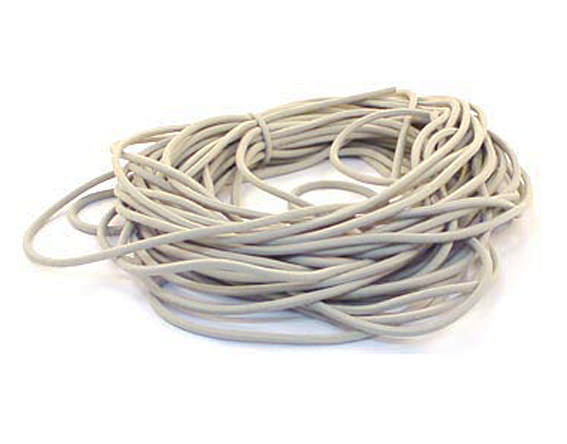
Hungarian:
- a less common type of rubber band;
- elongation coefficient 1.5–1.6;
- mainly used by aircraft modellers;
- less resistant to frequent casting;
- low service life.
The main tasks of this component:
- immersing hooks with bait in a body of water.
- tightening the hooks should occur silently and smoothly, which does not help to scare away the fish and knock down the bait.
- making it easier to catch the catch;
- the likelihood of breakage of leads is reduced due to shock-absorbing properties;
- with additional baiting of a place, due to the location of the load in one place, the bait is delivered to its original position.
Motoviltse
Another necessary component of a fishing rod. It applies:
- for winding the main line and elastic;
- the fishing rod becomes compact and does not take up much space.
Made from various materials:
- Tree . It is well processed and allows you to produce parts of various configurations and shapes;
- Metal . Difficult to process, variety of part shapes is limited;
- Plastic . Cannot be processed in home conditions and configurations. A reel made from it can be bought in stores.
Reel design:
- Monolithic . Serves as a fixation for the main fishing line on the shore. The fishing line and elastic band are wound together, but must be wound on separate fasteners.
- Reel _ The elastic should be removed from the main line and wound separately. When fishing, it is necessary to provide for securing the fishing line on the shore.
The reel must have a fairly strong design in order to not only withstand the tension from the elastic band, but also the force of the fish during the bite.
fishing line
When choosing the main fishing line for the elastic, you need to consider:
- casting distance;
- the behavior and weight of the fish to avoid cliffs while fishing;
- mechanical properties of the fishing line: tensile and breakage.
Selecting line length and diameter:
- main line diameter 0.4–0.5 mm;
- line diameter for leashes 0.3–0.35 mm;
- The length of the main line depends on the stretchability of the rubber band. A supply of fishing line of 10–15 m is added to the length of the stretched rubber shock absorber;
- The length of the leashes is 20–30 cm.
In the traditional version of the elastic band, a fishing line made of nylon or nylon is used. For a fishing rod designed for larger fish : carp, carp, silver carp and for longer casting, it is recommended to use braided fishing line as the main one.
Hooks
They perform a significant function in the fishing process. Because they carry bait, they need to be the right size for fish to bite and of reliable quality.
When choosing a hook for a fishing rod, you need to assume the future catch:
- hooks No. 1-3 are designed for fishing for the smallest fish;
- hooks No. 4-6 are used to catch roach, crucian carp, medium-sized roach or small bream, bream;
- hooks No. 7-10 are used for larger representatives of the family, such as: bream, silver carp, carp, carp;
- hooks No. 10-15 are designed for the largest fish, for example, pike perch, catfish and other large representatives.
Leashes
Hooks are attached directly to the leashes.
Types of leashes:
- Removable . They are made from fishing line 0.3–0.5 mm up to 30 cm long with a loop at the end. They are attached with rings and painted to match the color of the bottom.
- Fixed . They are made from a fishing line 0.2–0.3 mm long from 20 to 30 cm with a loop at the end. They are attached with glue and wrapped with nylon or thin silk thread on top.
Location of leashes on the main line:
- when fishing for sabrefish, crucian carp, roach or other “calm” fish, leashes are placed at a distance of up to 30 cm from each other;
- when fishing for predatory fish: pike, perch, the distance between the leashes should be increased to 40–50 cm, and the length of the leash should be 30–40 cm.
Guided by their experience, professional fishermen advise attaching leashes through a swivel so that they do not get tangled when the main line is twisted.
Swivel
This piece of gear plays the role of a connecting link.
What is it used for:
- Used to connect one end of the elastic to the end of the main line to prevent the main part of the welt from twisting.
- It is used with removable leashes and also prevents them from twisting during removal and retraction from the water.
Spring
It is an effective tackle for catching peaceful fish: crucian carp, carp, bream, etc. Designed for bottom fishing and is a feeder.

Types of springs:
- with and without a sinker;
- cylindrical;
- conical;
- curved.
What is it used for:
- Less open springs are used on reservoirs with high currents so that the bait remains in the feeder longer;
- More open ones are used on reservoirs with standing water and rivers with low flows.
Feeder
It is designed for storing bait.
It can be not only a container for bait, but also a sinker. Forms and places of application:
- “ cage ”, used for fishing on lakes, stakes;
- “closed” type springs , used in reservoirs with weak currents or standing water;
- square , needed for fishing on rivers with strong currents;
- triangular , used on deep and mountain rivers.
Sinker
When fishing with a bottom fishing rod with a rubber shock absorber, it acts as an “anchor”.
Types of sinkers:
- sliding , due to the free passage of the fishing line through the load, when biting the fish does not feel resistance and is more willing to take the bait;
- suspended , when using this type of sinker, the bait “plays” freely under the influence of the water flow, the better it attracts fish;
- deaf , due to the immobility of the load, the bait lies on the bottom and becomes unnoticeable. They come in different shapes and sizes. Mostly made from lead.
Baits and baits
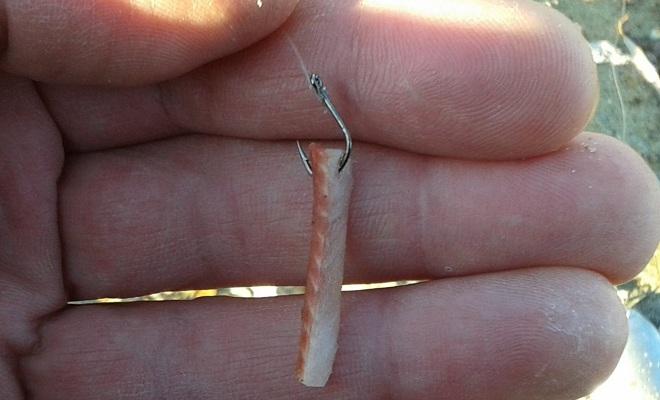
The rubber band for fishing has enormous potential in terms of using baits and lures, which absolutely coincides with the possibilities of catching various types of freshwater fish. Both plant and animal baits are used in rigs; in addition, animal baits can be not only inert, but also mobile in the form of all kinds of fry. Due to the smooth casting of vegetable baits, mastyrka, hominy, bread crumb and flavored dough are used without restrictions on their size. Boiled and steamed grains of cereals and legumes, young boiled potatoes, sliced vegetables and fruits also go into use without any modifications.
Among animal baits, common baits include worms, bloodworms, maggots, leeches and various types of insects. It is convenient to catch with pieces of liver, fish fillets, crayfish meat and shells. Using tees and doubles, baitfish and frogs are placed on leashes.
Gumbait
“Rubber” is more designed for catching peaceful fish, so the following are usually used as bait:
- Earthworm.
- Maggot.
- Caddisfly.
- Bark beetle
- Grasshopper.
- Leeches.
- Dough.
- Bread.
- Semolina.
Live bait is used to catch predators. For example, night fishing with an elastic band is not complete without live bait. With the arrival of evening, the number of leashes decreases from 3-4 to 2. A small ruff, ruff, gudgeon, minnow or spruce clings. A common nocturnal predator in my area is burbot.
How to make a rubber band for fishing
In practice, assembling an elastic band for fishing is not difficult, and this does not require any special material costs. Most of the components of fishing gear are purchased at a fishing store, and some elements can be found at a construction or manufactured goods outlet, or simply picked up from available material. Lines and hooks are purchased from fishing nets.
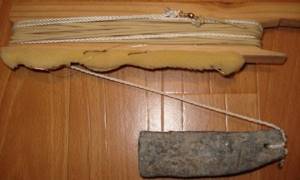
The model and plywood blank for the reel are purchased from manufactured goods, and the load, based on the mass needed for fishing, is selected from any object suitable for this role, be it a metal blank or even a brick. The reel is cut out with a hacksaw from plywood, 20 mm thick, making 30x10 cm slots along the ends of the rectangle, required for the volume of fishing line depth in the form of a dovetail. To avoid the formation of burrs, the reel board is ground with fine sandpaper. A cord is attached to the reel, which can be taken in the form of monofilament or braided fishing line. Monofilament is used in a thickness of 0.25 to 0.70 mm. The braids are taken thinner, adapting diameters of 0.2-0.4 mm to the base. The length of the base varies from 20 to 100 meters, and more if necessary. Leashes are knitted from nylon with a length of 10 cm and above. The diameter of the leash material depends on the expected size of the trophy.
Important! Metal or fluorocarbon leashes are used for pike to prevent overbiting.
A round model is used as a shock absorber. A rubber band diameter of 0.7 to 1.2 mm is considered practical. The selection of thickness depends on the length of the base and the total mass of the bait being installed. For short-length donks and fishing with rigs in still water, purchased blind sinkers are used. For heavy and long equipment, it is more convenient to use brick or shaped paving slabs as a load. We will talk in more detail about some of the nuances of selecting and connecting equipment elements in the continuation of the article.
Detailed characteristics of the components of the gear
The thickness of the main line depends mainly on what kind of fish you plan to hunt. When choosing a fishing line for rigging the “elastic band” of the main part, you should give preference to a thickness of 0.2 to 0.4 mm. The length does not exceed 15 meters.
A fishing line of a thinner diameter is used when catching crucian carp and perch. When going fishing for carp, pike perch should be provided with thicker and stronger fishing line.
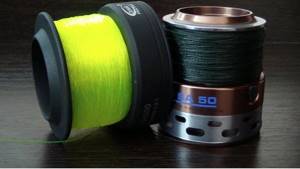
In order not to tear the main line in case of a snag, a line slightly thinner than the main line is used for leashes. When making leashes, you can attach them to different lengths. Often the length ranges from 10 to 70 cm. Basically, leashes are attached to the same length. Attaching hooks of different sizes can ensure the catch of different fish. This also makes it possible to catch fish with different baits, using maggots and worms in one cast.
Since the length of the “elastic band” can increase up to 5 times, it is worth taking this factor into account when choosing a shock absorber. For rubber tackle, a rubber shock absorber with a round cross-section would be an excellent option. The length of the shock absorber will depend on the fishing conditions provided, and, of course, based on the ability of the gear to stretch.
The sinker for the tackle can also be made independently. The factory load for such gear usually weighs about a kilogram, the composition is lead. You can also make it yourself from metal, or use a piece of brick or stone. But you should not choose heavier than the desired weight. The main task of the sinker is to hold the tackle in the place where it was thrown, and not lie on the bottom as a “dead weight”. The sinker is attached to an “elastic band” on a nylon cord up to a meter long. Nylon is used to ensure that the tackle can be cast further at a time, without much effort.
The moment of biting must be noticed immediately. For this purpose, the tackle is equipped with a signaling device. It can also be purchased, but you can also use improvised means found on the shore. Thus, many fishermen use a small, thin piece of willow branch as a signaling device. Purchased alarms are more technically advanced, since most of them are electronic. Do not neglect this installation, relying on your skills. The main thing in fishing is hooking at the right time.
A float tied to a rope is only relevant when fishing with a rubber band from a boat. In this case, the float, like a beacon, indicates the place where the load is lowered. The process of fishing out of a boat is not only easier, but also allows you to expand your fishing horizons.
The “elastic band” is wound on the reel after use. It is produced independently. To do this, you can use a piece of wood or hard foam. The length of the finished reel is 50 cm. In this state it is stored and transported. If you choose a wooden reel, you should pay attention to plywood. Material thickness from 5 mm. This will make it more durable. Using a fishing rod and reel is not recommended. This will complicate the process of winding and unwinding the fishing line with an elastic band.
How to calculate the length of an elastic band for a tackle

Correctly equipping the elastic band with the optimal length of the shock absorber affects the operation of the entire gear. The cut size of the model can be calculated based on a simple formula consisting of the total footage of the main fishing line adjusted for the stretching coefficient of the model, which is a constant value and equal to 7. To eliminate the maximum tensile load and increase the overall reliability of the tackle, we accept a working factor of 5 and simply determine the required one for for comfortable fishing, a piece of elastic. The length of the model will be equal to the footage of the base divided by a factor of five. It is in this mathematical way that the length of the fishing elastic shock absorber can be most accurately determined, regardless of other conditions for bottom fishing.
Calculation of the length of the finished gear
The maximum stretch of the elastic band is up to 7 times. This stretch borders on possible line rupture. Therefore, when calculating the length of the elastic, you should take the stretch value by 6 times.
Length of elastic band = length of fishing distance / by 5.
In this case, 5 is the stretching error of the elastic band itself, with a margin. This means that if you plan to fish within 25 m from the shore, you should take a rubber band of at least 5 m. Further, according to the calculations. If it is 50 m, then the elastic band is 10 m, respectively.
How to tie an elastic band with fishing line
The overall performance of the equipment depends on the reliability of the connection between the base and the shock absorber. Sometimes, when the bite is good, the donk often has to be taken out of the water to land fish and change bait. When performing these operations, the main load falls on the junction of the cord with the shock absorber. Particular attention is paid to the careful connection of these elements in the overall design of the catching tool during the manufacture of elastic bands. In particular, from fishing practice, fishermen have chosen a number of effective and reliable methods for connecting these parts.
The most common way is to connect elements loop to loop. For these purposes, blind loops are knitted at the ends of the dissimilar materials being connected. Instead of direct ties, you can include additional accessories in the connection in the form of a swivel tied to the main fishing line and a carabiner that is attached to the shock absorber and connect the parts in this way.
An original and very reliable method is to connect into a tube. We put a polyurethane tube or plastic cambric over the shock absorber material and knit a blind loop. Then the tip of the main fishing line is inserted into the tube and a blind loop is also formed. The result is a connection without pulling together dissimilar materials, which does not cut the elastic and does not deform the structure of the main cord.
What is a rubber band?
The design of the gum bottom consists of:
- cargo;
- cord 50 cm long;
- a piece of elastic;
- areas with leashes;
- main line;
- a reel on which the tackle is wound at the end of fishing;
- racks for fixing equipment on the shore;
- signaling device.
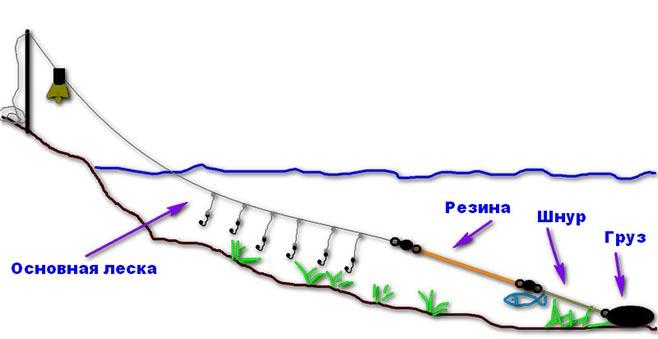
For the convenience of working with tackle, especially when fishing for large trophies, instead of a reel, use a spinning rod with a reel on which a fishing line is wound, acting as the main one. When catching small fish, crucian carp or bream, the rubber band is pulled out by hand.
It is believed that this is gear for catching small fish, but using strong and reliable hooks and a thick base, carp and grass carp and even silver carp are caught with an elastic band. To ensure that the hooks with nozzles are delivered to the same place every time, the elasticity of the rubber is used, tied to the load located at the fishing point. The weight of the load must be sufficient to hold the stretched elastic band; for this, use a stone or a lead barrel.
When using a stone, you should not tie it with wire, because after breaking, the stone will remain at the bottom of the reservoir, and the wire will rust and harm the environment. Using a rope will allow you to make reliable gear and at the same time take care of the purity of nature. If you tie an elastic band directly to the load, the risk of damage and breakage of the equipment increases, so an insert of thick cord is placed between them.
The cord is tied to the load at one end, and in the second way, a loop in a loop is connected to an elastic band. It is possible to combine an elastic band and a cord using a swivel or fastener freely rotating around its axis. Using a fastener simplifies the process of installing and dismantling the donkey, so this option is more convenient and simpler.
Which cargo is better
In the fishing elastic method, the weight plays the role of an anchor, holding the equipment in a stationary position throughout the entire fishing session, regardless of the external conditions of the reservoir. If on a body of water with stagnant water the shape of the load is not relevant, and only the mass itself matters, then when fishing on currents, the loads should be of a design that does not allow the stream to roll and drag the sinker freely along the bottom. For these purposes, it is better to use flat body shapes with notches over the entire surface area.
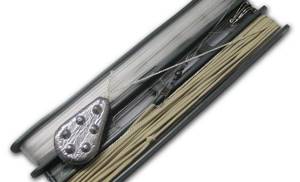
Of course, it is ideal to have a lead form with a fastening ring soldered into the body of the load, but in practice, a cheap and improvised weight is often attached, which is not a pity to leave at the bottom of the reservoir even after the shock absorber breaks. Angular stone or brick will always work for this purpose.
Bottom tackle device with rubber shock absorber
At the moment of casting a regular donkey, live bait, especially weak bait, often falls off the hook or is severely damaged and quickly dies. On bottoms with a rubber shock absorber, when you carefully release the fishing line, this does not happen; - it is possible to revive the bite by attracting fish by slightly moving the fishing line, changing the tension of the rubber, changing and combining bait attachments.
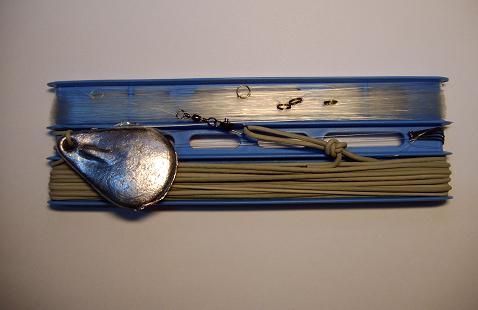
Donkeys with a rubber shock absorber also have disadvantages. They are as follows: - lack of maneuverability - the tackle is installed in one place and is difficult to move.
You should always have a supply of elastic bands and weights with you; - a tightly stretched rubber shock absorber can pose a danger to the fisherman: if an extended tackle comes off due to negligence, it can injure hooks, and if the elastic breaks, a strong blow occurs, which damages unprotected areas of the body (therefore, the hand pulling the elastic should be moved to the side).
A properly assembled and installed bottom with a rubber shock absorber allows you to catch roach, herring, perch, sabrefish and many other types of Volga fish.
A special feature of the design of such a donkey is that between the very heavy end sinker and the line (a fragment of the tackle on which the leashes with hooks are located) there is a thin, long elastic band of great extensibility - a rubber shock absorber.
The heavy sinker is designed to always hold the end of this elastic band at the bottom in one place. The elastic band, when stretched, allows you to manipulate the line without removing the sinker from the water.
In this way, the hooks can be pulled ashore, secured to a peg, inspected and calmly returned back to the fishing point without unnecessary noise. The most stringent requirements are imposed on the rubber shock absorber - the reliability of the gear and, accordingly, the fishing itself depends on this.
It’s a shame when, in the midst of a bite, the elastic suddenly breaks. The best material for a rubber shock absorber is aircraft model rubber with round section.
This gray elastic band, popularly called “Hungarian,” is especially reliable. Tape and square rubber ages and breaks faster, causing scoring on sharp edges.
The thickness of the elastic for such a donkey depends on the thickness of the main fishing line and the distance from the shore to the fishing point. The thicker the line and the greater the distance, the more powerful the shock absorber must be to effectively return the hooks to their place.
If there is no thick elastic band, it is permissible to use a “braid” of 2-3 threads. When purchasing rubber for a donkey, you should carefully check its properties and quality.
At maximum stretch, hairline transverse cracks should not appear on the rubber band. In such a situation, tape and square rubber should not show scoring on the edges or other damage.
The color of the elastic should be the same along the entire length, since yellowish and brown shades indicate a loss of strength of the material or poor-quality raw materials. Rubber that has lost its elasticity is generally not suitable for making donkeys.
When fishing, the rubber shock absorber should be protected from direct sunlight if possible and stored in a cool, dry place. The length of the rubber shock absorber depends on the distance from the angler to the fishing point and the extensibility of the material.
The approximate length of the shock absorber (L) can be calculated using the following formula: L = S/(n-1)S - distance from the fishing point to the shore; n - elastic stretch coefficient. Thus, if you need to design fishing gear at a distance of 50 meters from the shore with rubber, the elongation of which is 5 (extends 5 times), then the approximate length of the shock absorber will be: 50: (5-1) = 12.5 m.
This result should be increased by 1 meter so as not to stretch the rubber to its limit and be able to use a sinker of minimal weight. (
) By the way, the sinker is either cast from the shore or brought in by boat. In the second case, it does not need to be removed after fishing using the gear itself - you can pull it out of the boat by the buoy and, accordingly, it can be much heavier and more reliable (anchor, bag of sand, large stone).
When arranging a tackle with such a heavy sinker, you can select the length of the shock absorber on the spot by placing the free end of the elastic band on the shore, pulling it to the desired state and locally mounting a swivel at the end for attaching to the crossbar.
One of the options for equipping a donkey with a rubber shock absorber looks like this. The main line with a diameter of 0.40-0.80 mm is wound on the reel along one side (in a figure of eight).
The reel is made of plastic or waterproof plywood. On the other side of the reel, when installing the equipment, a rubber shock absorber, a crossbar with leads and other parts are also placed.
The first leash from the sinker is secured approximately one meter from the rubber. The distance between the leashes is approximately 1-1.5 meters - this significantly increases the fishing area and the chance of a bite.
The leashes are made short, approximately 8-12 cm, and attached to the line with a twist or special spirals to move the hooks away from the axis of the line while the gear is moving. All connections of the gear elements are made through swivels with carabiners; the ends of the rubber shock absorber are attached to the swivel or steel ring through rings made of durable rubber or soft plastic (to avoid damage to the rubber).
(.) The end of the rubber shock absorber is passed into the ring, and the free end of about 6 cm is laid in thirds along the elastic band, slightly stretching it at this moment and each time wrapping it with cotton thread - such a connection will hold well in water when the shock absorber is stretched.
About leashes
The length of the leash directly depends on the activity of fish bites. When the fish are inactive, experiment with increasing the leash until the bite stabilizes. When systematically hunting for pelagic fish species, saberfish and blue bream, leashes up to one meter in size are initially attached.
Important! As a rule, the leash material is secured to the base with a loop-to-loop connection.
The use of fasteners and carabiners affects the delicacy of the gear and is fraught with serious entanglements. The distance between the leads is taken to be at least five meters, thus fishing large bottom areas.
The subtleties of making tackle with your own hands
For fishing in the 21st century, you can use not only expensive store-bought tools, but also homemade inventions. If we talk about making rubber bands with your own hands, then this process does not require any skills, and all the necessary materials can be found in any hardware and fishing store. The tackle consists of:
- Main line.
- Rubber shock absorber.
- Leashes with hooks.
- A sinker that is tied with a nylon cord.
- Reels or reels for storing fishing line.
- Bluebell (used as a bite indicator).
When planning to start making elastic tackle, you need to find a good main fishing line in advance. It can be used as a monofilament thread with a cross-section of 0.40−0.50 mm.
If you are going to catch small fish, such as crucian carp or perch, then the optimal diameter is 0.20-0.25 mm. As for the length of the working cord, it is determined by the fishing range.
In any case, it is advisable to take several tens of meters more fishing line.
The leaders should be monofilament, but their thickness is slightly less than the thickness of the main line. The presence of leashes prevents damage to the gear in case of possible snags.
The optimal leash length varies between 10-100 cm and is determined by the mood of the fish, the bait used and the fishing conditions (spit or hole, current or not). The hook sizes are selected using the same principle.
The elastic band itself should have a circular cross-section and be from 5 to 20 m long. It all depends on the distance to which the bait needs to be delivered. In most cases, the shock absorber stretches 4-5 times, which also needs to be taken into account when choosing the optimal length.
You can use a brick, stone or a piece of lead as a sinker. The optimal weight is selected taking into account the strength of the current, the type of bottom and the distance at which fishing is carried out. A meter of thick fishing line or nylon cord should be attached to the sinker.
How to fish with an elastic band
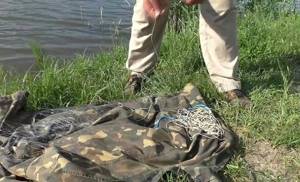
The fishing technique itself with this type of bottom tackle is not particularly difficult and even a novice angler can master it fairly quickly. The process algorithm is simple and consists of the following procedure:
- The donka is unwound from the reel and laid in rings in a spiral on the shore of the reservoir, so that the equipment elements do not get tangled.
- The next operation is throwing or delivering the cargo from the boat to the point where the gear is installed. When delivering cargo by means of a floating craft, the place where it is thrown is marked with a float for easy search after fishing is completed.
- Having anchored, the cord is taken out of the water and the hooks are equipped with a nozzle.
- After installing the bait, the line is released into the water, placing the bottom on the alarm.
How to cast, wind, fishing elastic
When throwing a rubber band from the shore, after unwinding the warp, the fisherman ties a sinker to the shock absorber, and attaches the reel to a peg, previously driven deep into the shore. Positioned away from the coils, the angler casts the load to the distance required by the fishing conditions.
Important! As a rule, you can throw the tackle no further than 25–30 meters with your hands.
When fishing on the river, you need to make allowances for the drift of the sinker by the current. Therefore, the casting point is selected taking into account this nuance. After a couple of minutes pause, the moment of reliable installation of the sinker on the bottom, further work with equipping the tackle begins. When winding a donkey from a boat, it is more convenient to unwind the fishing line on the shore and after that bring in the cargo. When lowering the sinker to the bottom, do not forget to make allowances for the current.
Fishing process
After supplying the bait, the excess main line is wound onto the reel, a bite alarm is installed and fishing begins. The bites on gear with a shock absorber are soft, without obvious explosions or sudden pulling of the cord from the trajectory of its installation. Following the bite signal, the angler makes a hook, pulling the line towards the shore. The caught fish immediately begins to show resistance, the jerks of which will be successfully absorbed by the elastic band.
The fishing itself is done at a calm pace, with the same speed of pulling the line out of the water to the leash with the trophy. The cord is carefully laid on the shore, avoiding overlapping of the rings. The fuss in this matter promises the next time you lower the bait, you will lose time on untangling the elements of the gear. The fish pulled to the shore are brought into the landing net, enjoying the already guaranteed catch.
Technique for fishing with a rubber band and casting from the shore
Let's look at all the tricks of fishing with an elastic band, starting with the obvious advantages of the method:
- The load is cast once, and there is no need for repeated casts to scare away the fish.
- The elastic band does a good job of absorbing the jerks of strong fish.
- The process of changing bait is simplified - it is done by weight.
- Baited hooks always return to the same place.
- The donka with an elastic band has excellent sensitivity to bites.
There is only one drawback - without certain casting skills, you can seriously tangle the line. However, if everything worked out, further fishing will not be difficult.
Carefully study the video, it clearly shows how to cast and not tangle the line.
How to throw (start) a donk with an elastic band
- Before casting, all the gear, from the elastic to the reel, is unwound and laid out in a spiral on the shore, so that there is no interference from stones or vegetation.
- A weight is securely tied to the end of the elastic band.
- The reel with a supply of fishing line is attached to a peg (you can hold it in your free hand).
- Standing on the side of the laid out fishing line, the fisherman casts the load to the desired place. If this is a river, you should take into account the drift of the load by the current before it sinks to the bottom.
- A pause of 5-10 minutes is taken so that the load settles securely to the bottom.
- A section of fishing line is pulled ashore where the leashes will be attached. Above it, a loop is made on the fishing line, which clings to a specially installed slingshot, so that there is free access to all leashes.
- The leashes are hung, the bait is attached, and the line is carefully released into the water.
- Excess fishing line is wound on a reel, which is attached to a pre-driven peg.
- All that remains is to attach a guard (a bell or other bite alarm) and wait.
- If casting is carried out from a boat, the current of the river must also be taken into account. Sometimes it makes sense to lay out the tackle along the shore, against the flow of the water, in order to start the boat ride from there, and in the right place lower the load with the buoy to the bottom.
- If you plan to fish at shallow depths in the summer, you can wade the load.
These are the general rules for throwing a rubber band. But the process of catching a particular fish can vary significantly.
Pike perch on a spinning rod - a guide to choosing tackle, bait and a story about the technique of catching a deep-sea fanged hunter.
The best fishing knot - it does not come undone, does not reduce the strength of the connection and does not move, learn how to knit a figure eight correctly.
How to prepare bait for bream - the best recipe, list of preferred ingredients and flavors.
Catching sabrefish with an elastic band
Chekhon is the most popular fish that you can catch without a rubber band.
The rubber band seems to be specially created for catching sabrefish - it is this tackle that allows you to get the richest catch. The best time to catch this fish is from May to September. She loves shallow rocky or sandy sections of the river, usually walking in schools, closer to the surface of the water.
Lure
- A mixture of breadcrumbs and millet porridge (1 to 1) is good for baiting sabrefish. The finished cooked mixture is placed in a feeder made of fine mesh. It is installed at a distance of 5-6 meters from the location of the hooks upstream. It is tied to a buoy at the surface of the water and secured at the bottom with a weight.
- You can also use a plastic bottle with frequently made holes, and even uncooked millet groats or breadcrumbs as bait.
- The bait is gradually washed away by the water and goes downstream, thereby attracting shoals of sabrefish to the fishing spot.
Bait and fishing technique
- The best option for sabrefish is maggots, 4-5 pieces per hook. Closer to autumn you can use fry.
- The bait should be located closer to the surface of the water, so be sure to install a float between the elastic band and the area with the leashes. It can be a foam ball with a diameter of about 5 cm, or a hollow factory one with good buoyancy.
- The saberfish reacts more actively to moving bait, so it is necessary to “play” with it. The line is held in the hand, a sharp jerk is made, then smoothly released into the water until it stops. Pause for about 3-4 seconds, and the cycle repeats. Sometimes you can add variety to the game by changing the frequency and duration of jerks.
How to catch crucian carp with an elastic band
Crucian carp, especially small ones, go very well on elastic bands
- This is perhaps the most uncomplicated type of fishing. Crucian carp loves everything, and you can use bread, hominy, worms, maggots, and bloodworms as bait.
- The most important thing is to feed the fishing spot well, and in a well-chosen area (and crucian carp can be found everywhere) you will not be left without a catch. This fish loves fragrant baits, so the best option would be to use pureed sunflower, flax or hemp seeds in their composition.
- To make fishing more effective, you can put feeder spring feeders filled with bait on the fishing line between the leashes. The rubber band is released into place and shaken vigorously so that the nutritional mixture comes out of the feeders. This procedure is repeated 2-3 times. As a result, a well-fed fishing zone is formed exactly in the place where the crucian carp will be waiting for bait on the hooks.
Catching bream with an elastic band
Bream is a large schooling fish, which makes it possible to successfully catch it with an elastic band.
All fishermen know how shy and cautious the bream is. If any technical liquid gets on the tackle, it is better not to use it - you won’t get a bite. So the gum should always be kept perfectly clean.
What are the features of bream fishing?
Lure
Without this, bream cannot be caught. We recommend not using store-bought mixtures as food, but steaming peas. For one bottom fishing rod, about 2 kg, boiled over low heat for 10 minutes, will be enough.
The bait should be scattered over the place where the bait is installed at least one and a half to two hours before the intended fishing. To determine exactly how the hooks will be positioned on the bottom, it is recommended to attach pieces of foam plastic to them and test the fishing line into the water. This way you can clearly see how the fishing line is positioned on the bottom, taking into account the underwater current. The fertilizer is scattered along this trajectory.
Bait
- Bream is a fairly omnivorous fish, but the best option, of course, is medium-sized dung red worms. 5-6 worms are hung on a hook (No. 4-6), the tip is always hidden.
- The leash for bream is usually made 20-25 cm from 0.2-0.25 mm fishing line. The optimal number of hooks is up to 5 pcs.
Catching
- Waiting for bream bites in the daytime is almost pointless. Its time is early in the morning, at dawn, or after 6-7 pm. If you stubbornly plant worms throughout the day, small things will annoy you and are not worth your attention.
- It is difficult to confuse the bite of a bream with another - at first the guard moves slightly back, and then confidently moves forward by 15-20 centimeters. Now you can hook, and, most importantly, do not let the bream go towards dense thickets. The elastic band will help absorb strong jerks. All that remains is to carefully lead it to a place where it can be picked up with a landing net, or to the shallows, where it will lie on its side.
It is obvious that a well-designed bottom fishing rod with an elastic band in the hands of a skilled fisherman turns into a universal tool. And what is also important, fishing with an elastic band can allow you to be distracted by other, more active types of fishing.
